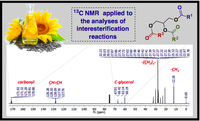Comparison of the regiospecific distribution from triacylglycerols after chemical and enzymatic interesterification of high oleic sunflower oil and fully hydrogenated high oleic sunflower oil blend by carbon-13 nuclear magnetic resonance
The nutritional and organoleptic attributes of oils can proceed via interesterification of oils blends catalyzed by enzymes or chemicals. Enzymatic interesterification processes are preferred due the regiospecific outcome. Traditionally, monitoring of distribution of fatty acids in glycerol backbone is performed by enzymatic and chromatographic methods that are time-consuming, involving a series of chemical manipulations employing large volumes of organic solvents. Alternatively, C-13 NMR is a fast and reliable technique that could be applied to determine the saturated and unsaturated FA distribution of the triacylglycerols present in high oleic sunflower oil and fully hydrogenated high oleic sunflower oil blends and their interesterification products. The enzymatic interesterification was conducted employing the immobilized lipase from Thermomyces lanuginosus, the results show that the process was not completely regiospecific at sn-1,3 positions, due to the spontaneous acyl migration from position sn-2 to sn-1,3.

